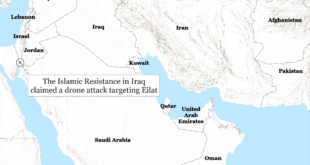KABUL: Sitting and eating quietly on his father’s lap, the 18-month-old boy was oblivious to the infection running through his veins.
But his father, a burly farmer, now a widower and father of four, knew only too well. It was the same one that killed his wife, the boy’s mother, four months ago. The man started to cry.
“When my wife died, I thought, well, it is from God, but at least I have him,” he said. “Then I learned he is sick too. I asked if there is medicine and the doctors said no. They said, ‘Just trust in God.'”
Long cloistered by two decades of war and then the strict Islamic rule of the Taliban, Afghanistan was for many years shielded from the worst ravages of the AIDS pandemic. Not anymore.
HIV and AIDS have quietly arrived in this land of a thousand calamities. Still, little is known of the disease in Afghanistan. It remains almost completely underground, shrouded in ignorance and stigma as the government struggles with the help of U.S. and NATO forces to rebuild the country amid a new offensive by Taliban insurgents.
![]()
The father of the boy, Afghanistan’s youngest known HIV sufferer, agreed to speak to a reporter only on condition their names and other details be omitted. He has not even told his family what disease his son has.
He believes that his wife contracted it through a blood transfusion she received during surgery in Pakistan years ago. The few surveys that exist suggest that Afghanistan has a low prevalence of HIV — there are only 69 recorded cases of people contracting the virus, three of whom have died. Yet health officials are warning that the true incidence of HIV and AIDS is much higher.
“That figure is absolutely unreliable, even dangerous,” said Nilufar Egamberdi, a World Bank consultant on HIV/AIDS. The World Health Organization has estimated that 1,000 to 2,000 Afghans are infected, but Egamberdi said that even those numbers were “not even close to reality.”
Saifur Rehman, director of the national AIDS control program in the Ministry of Health, agreed. Afghanistan, a deeply religious and conservative country with strict social mores — sex outside marriage is against the law — may still be less at risk to the spread of the disease than other places, some argue.
But international and Afghan health experts warn that the country has a unique set of vulnerabilities — poor education and government services, the mass movement of people, and the sudden influx of aid, commerce and outsiders since the U.S. invasion in October 2001.
Afghanistan borders countries with the fastest-growing incidence of AIDS in the world — Russia, China and India. Its other neighbors, Pakistan and Iran, have high levels of drug addiction and growing HIV populations, as does Central Asia to the north, experts said.
Experience in other countries has shown that AIDS can easily cross borders, carried by migrants or returning refugees who picked up drug habits or had sex with infected people in those countries. And rates of drug addiction are rising in Afghanistan itself, along with its booming opium crop and the growing availability of heroin.
But even though the Afghan government and senior religious leaders have won praise for making the problem of HIV a national priority, they are struggling to manage many problems.
“In Afghanistan, all the traditional risk factors for rapid spread of HIV exist concurrently,” said Fred Hartman of Management Sciences for Health, a nongovernmental organization in Boston that is working in Afghanistan. He has worked as technical director of Reach, an American-financed program to expand health care to Afghanistan’s rural communities, and advises the government on HIV/AIDS.
The return home of more than two million refugees has played a part in the spread of the disease, said Renu Chahil- Graf, regional coordinator for Unaids, the United Nations program, who was visiting Pul-I-Charkhi prison in Kabul, where a testing clinic has opened.
Some of those returning to Afghanistan from working abroad have drug habits, and they spread AIDS by contact with spouses, prostitutes and street children, Rehman said.
Afghanistan, the biggest opium- and heroin-producing country in the world, has nearly one million drug users, according to UN estimates. Most users still smoke the drug rather than inject it.
But five years ago, injectable heroin hit the streets of Kabul, and intravenous drug use is increasing, with an estimated 19,000 intravenous drug users here, according to the World Bank. Addicts are not difficult to find, living in bombed-out buildings in the old part of the city and in Kota-e-Sangi, a neighborhood on the south side.
They are homeless or returned refugees fallen on hard times, mostly young men, said Miodrag Atanasijevic, a coordinator for Doctors of the World, a French aid group that runs a clean needles program in Kabul.
“It will become a huge thing,” he said. “In this country you have a lot of drugs.”
Even after five years of international assistance to the health sector, only 30 percent of blood used in transfusions in Afghanistan’s hospitals is screened for HIV, says a World Bank report.
Eighty percent of government hospitals now screen blood, Rehman said, but he acknowledged that many institutions do not. Health workers remain ill-informed about HIV and careless, often reusing needles even when they know the practice can spread the disease, he said.
While several organizations are working to provide needle exchanges and to increase awareness of HIV, a far wider program is needed, said the World Bank, which is providing $10 million to fight HIV/AIDS in Afghanistan.
![]()
A recent study of 461 intravenous drug users in Kabul showed that 3 percent were HIV-positive, Rehman said. He, like many officials, cited the situation in neighboring Pakistan as a warning.
There, drug users identified as HIV- positive in Larkana, near the port city of Karachi, were stoned and chased from the area when the local people learned of their infections. They then drifted into the vast city of 16 million, and went underground. Within just two years the HIV rate among drug users skyrocketed from 2 percent to 26 percent, Rehman said, citing a survey on the episode.
“I don’t know what to do,” he said. “I have sacrificed so much since my marriage. I mortgaged half my land to pay for her medical care.” Even if he keeps his secret, he can do little for his son. The country has no antiretroviral drugs.
The stigma of HIV/AIDS is perhaps the largest obstacle Afghanistan faces. The Taliban government, with its stoning and execution of adulterers and homosexuals, may be gone, but sex outside marriage and homosexual sex are still socially unacceptable.
Doctors and health workers here warn that AIDS sufferers will face ostracism, even death, if their communities learn they have the disease. The Ministry of Health is closely guarding the identity of the few people who have tested HIV-positive.
Muhammad Farid Bazger, HIV/AIDS coordinator of the German nongovernmental organization ORA International, has seen firsthand the cruelty communities are capable of in neighboring Pakistan and his native Afghanistan.
During his work in villages and refugee camps in Pakistan, he came across an unmarried man who had returned from the Arabian peninsula infected with HIV. The man told his father, who, not understanding the consequences, told others, and soon the whole village knew.
The villagers told the father he should kill his son. He was swiftly ostracized and then locked up in a brick cell in the family yard, with only a small opening where food was thrown in.
Bazger and his colleagues eventually rescued him and made a film of his story, which has been shown on an Afghan television channel.
Scores of foreign prostitutes have arrived in Kabul in recent years, capitalizing on the influx of foreigners. Afghans are using their services as well, particularly the well-paid young men employed by foreign organizations, health officials warn. Sex between men is a serious crime here, but health officials say this has not eradicated homosexuality. Gay men, many unaware of the risks, often have unprotected sex, putting them at high risk of contracting HIV.
Afghanistan’s efforts to combat AIDS have been stymied by a lack of money and a lack of urgency among donors who regard Afghanistan as a country with low prevalence of HIV, Hartman and others said. Afghanistan’s application to the Global Fund for AIDS programs failed last year. Even United Nations agencies have been slow to develop HIV/AIDS education, saying that they need to see figures documenting more AIDS cases, Egamberdi said.
Until this year, the members of the government AIDS team worked out of a shipping container on the grounds of the Health Ministry. Now they have graduated to a drafty, unheated hall inside the main building. While the World Bank has granted Afghanistan money to gather data and work with high-risk groups, Rehman hopes for an AIDS treatment ward in Kabul, testing around the country and antiretroviral drugs for AIDS patients remain unfulfilled.
His ministry has even enlisted the Ministry of Hajj and Religious Affairs to educate mullahs, often the most influential people in Afghan villages, about HIV and AIDS to help promote basic health education and mitigate the stigma.
The man interviewed for this article has not shown positive for HIV in nearly a year of tests, despite the death of his wife from an AIDS-related illness.
 Eurasia Press & News
Eurasia Press & News



